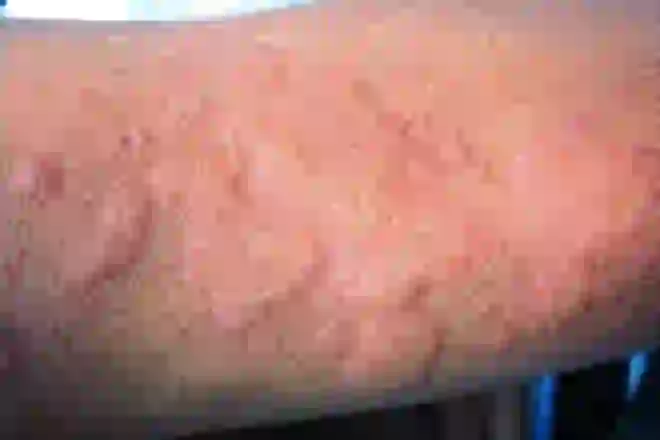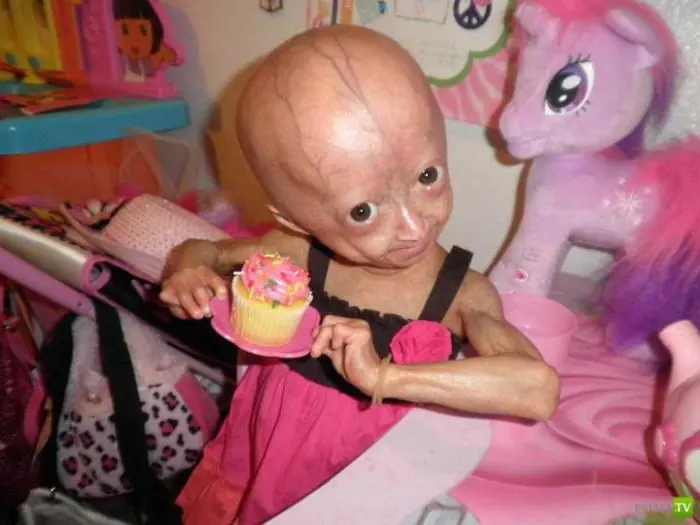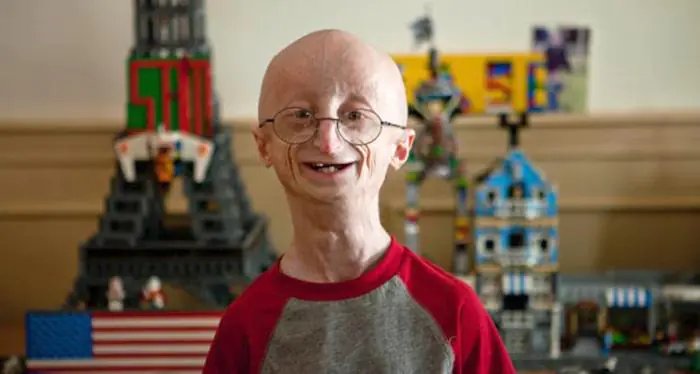
All people get old. According to scientists, if it were not for the destructive effects of the external environment and our addictions to pleasures harmful to the body, we would live up to 130, or even up to 150 years. And 16 years ago, on August 29, 2001, scientists even announced that they had found a longevity gene. So, perhaps, in the near future we will be able to live out the entire lifespan allotted to us by nature. But for now, we are aging and dying, the vast majority before the age of 80-90. And some diseases shorten this already not so long period by several times. And the most “killer” among them, in the literal sense of the word, is progeria. MedAboutMe found out what it’s like to grow old in one and a half to two decades.
What is aging?

Aging is a natural process characteristic of every living organism on Earth. All existing theories on the topic “Why do people age?” can be divided into two large groups. Proponents of one of them argue that aging was intended by nature for the further evolution of species and society. Others are sure that there are no global plans here - simply damage at the gene and cellular level accumulates over time, which leads to wear and tear of the body.
One way or another, over the course of a person’s life, the results of internal failures and errors, as well as the consequences of external influences, accumulate in his cells and tissues. Among the key factors of aging are the following:
- Exposure to reactive oxygen species (ROS), which, of course, our body needs, but not always and not everywhere.
- Mutations in the DNA of somatic cells (that is, body cells). The genome is not a structure frozen in time and space. It is a living and changeable structure.
- Accumulation of damaged proteins, which are a byproduct of ROS or disruptions in metabolic processes.
- Shortening of telomeres—the ends of chromosomes. True, recently scientists have begun to doubt that aging is associated with telomeres, but so far this theory is still popular.
Progeria, which will be discussed in this article, is not aging - in the sense in which science understands it when it talks about life expectancy, wear and tear of the body, etc. This disease looks like aging, although in fact it is severe a genetic disease associated with impaired production of certain proteins.
Progeria - diseases of children and adults
The Englishman Jonathan Hutchinson in 1886 first described a 6-year-old child in whom he observed skin atrophy. The name of the unusual disease (from the Greek word “progeros” - old before its time) was given to it in 1897 by Dr. Guilford, who was studying and describing the nuances of the disease. In 1904, Dr. Werner published a description of adult progeria using the example of four siblings who suffered from cataracts and scleroderma.
It is believed that Francis Scott Fitzgerald wrote his story “The Curious Case of Benjamin Button” in 1922 precisely under the impression of information about progeria patients. In 2008, Brad Pitt played the book's protagonist in the film The Curious Case of Benjamin Button.
There are two types of progeria:
- A disease that affects children is Hutchinson-Gilford syndrome.
This is a rare pathology. It occurs in 1 child out of several million. It is believed that in the world today there are no more than a hundred people suffering from childhood progeria. However, scientists suggest that we can talk about about 150 more undiagnosed cases.
- A disease that affects adults is Werner's syndrome.
This is also a rare disease, but not as rare as childhood progeria. People with Werner's syndrome are born in 1 case in 100 thousand. In Japan - a little more often: 1 case in 20-40 thousand newborns. In total, a little less than 1.5 thousand such patients are known in the world.
Genes and "aging"

Childhood progeria is only indirectly related to actual aging. This is a disease from the group of laminopathies - diseases that develop against the background of a problem with the production of the lamin A protein. If it is not enough, or the body produces the “wrong” lamin A, then one of a whole list of diseases develops, which includes Hutchinson-Gilford syndrome.
The cause of childhood progeria is a mutation in the LMNA gene, which is located on chromosome 1. This gene encodes the compound prelamin A, from which the protein lamin A is obtained, which forms a thin plate - the lamina - covering the inner membrane of the nucleus. It is necessary for anchoring all kinds of molecules and internal structures of the nucleus. If lamin A is missing, the internal framework of the cell nucleus cannot be built, it cannot maintain stability, which leads to accelerated destruction of cells and the entire organism. In addition, lamin A plays a key role in cell division. It regulates the breakdown and restoration of the cell nucleus. It's not hard to imagine what can happen if this protein is missing or not what it should be. Mutation of the LMNA gene leads to the formation of the “wrong” protein - progerin. This is what causes the accelerated “aging” of children.
According to the latest data, the mutation occurs in the early stages of embryo development and is almost never transmitted from parent to child.
Several years ago, scientists discovered that progerin is also produced by healthy cells, but in significantly smaller quantities than in Hutchinson-Gilford syndrome. Moreover, it turned out that with age, progerin increases in normal cells. And this is the only thing that really connects childhood progeria and the aging process.
Adult progeria is the result of another mutation, in the WRN gene. This gene encodes a protein necessary to maintain chromosomes in a stable state, and is also involved in the processes of cell division. If there is a mutation in the WRN gene, the structure of the chromosomes constantly changes. The frequency of spontaneous mutations increases 10 times, while the ability of cells to divide decreases by 3-5 times compared to healthy cells. Telomere length also decreases. And these processes are already really close to the aging that we mean when looking at elderly people on a bench.
Progeria in children

In children, the disease first manifests itself after a year or two. These babies have a short stature that is not appropriate for their age, a large head with a characteristically reduced facial part, a thin nose that looks like a beak, and protruding ears. Characteristic signs include micrognathia (underdeveloped lower jaw) and exophthalmos (bulging eyes). Progerics have a very thin layer of subcutaneous fatty tissue and thin hyperpigmented skin - it dries quickly and becomes wrinkled, looks translucent, flabby, with translucent blood vessels. Their nails are either not fully developed or absent altogether. Hair quickly turns gray and falls out, even eyelashes and eyebrows are sparse and thin. All this gives them the appearance of little old men with a characteristic appearance. Hence the myth about rapidly aging people.
Patients with progeria usually develop delayed sexual development, and tests show elevated levels of cholesterol and lipoproteins in the blood. But the intelligence of progerics does not suffer. The average life expectancy of such children is 13 years. A man with childhood progeria who lived for 27 years became a “long-liver.”
Some people with childhood progeria have accomplished more in their short lives than many of us. Leon Botha is one of the long-lived progerics; in the 26 years allotted to him, he managed to become a famous artist, musician and popular DJ. And Sam Burns from the United States, who died in 2014 at the age of 17, became famous as a motivational speaker and activist in the field of disseminating information about his disease.
The main cause of death in people with Hutchinson-Gilford syndrome is atherosclerosis, which affects the entire body, and myocardial fibrosis, the replacement of the heart muscle with connective tissue. In this case, a fat-like substance is deposited in the brain, kidneys, liver, ovaries (in women) and testicles (in men), and the bones become thinner.
Progeria in adults
In adults, Werner syndrome first appears between 14 and 18 years of age. They also experience a sharp decrease in weight, growth stops, gray hair appears, and baldness develops. Their body is rapidly deteriorating: disturbances in the functioning of the kidneys, liver and endocrine glands are observed, osteoporosis, atherosclerosis, diabetes mellitus, cataracts and myocardial infarction develop. Men and women experience changes in the reproductive system, which leads to infertility. Every tenth person with adult progeria is diagnosed with a malignant tumor at the age of 30-40 - breast cancer, melanoma, sarcoma, etc. Such patients live until about 45-50 years of age and die from cancer or heart disease.
Unlike childhood progeria, with Werner's syndrome the patient's mind also suffers.
In search of a cure for premature aging

There is no cure for progeria yet. Doctors are trying their best to slow down the rapid “aging” of such patients. Children with Hutchinson-Gilford syndrome are prescribed medications with antioxidant properties, vitamin E, etc. They undergo coronary artery bypass surgery in an attempt to cope with complications in the heart and blood vessels.
A drug that can extend the life of a patient with childhood progeria by a year, or at best by 6-7 years, is lonafarnib, a drug created to treat cancer. For a person whose life can end at 13-17 years old, this is a significant period. In 2012, it was found that taking it leads to improved hearing, stronger bones, increased body weight and increased vascular flexibility. 6 years is not that long, but the creation of many effective drugs began with similar achievements.
Encouraging results were also obtained with therapy with the following drugs:
rapamycin, an immunosuppressant that prolongs the life of the muscles of children with progeria;
pravastatin, which lowers cholesterol levels;
zoledronate, which slows down the development of bone metastases in cancer.
Is progeria prevention necessary? Previously it was thought that no, since people with childhood progeria did not live long enough to be able to give birth to children, and adult patients developed infertility. True, in recent years there have been reports of women with progeria giving birth to healthy children. But this disease is so rare that the likelihood of mutations spreading is extremely low.
No cure has yet been found for adult progeria. In such patients, only those severe and numerous diseases that attack them are treated.
Science does not stand still, especially in the field of medicine. Our ancestors could not even imagine that in the future diseases such as consumption (tuberculosis) or plague would become curable. But even with such progress, there are 15,000 diseases in the modern world. And while a person can cope with many viral or infectious diseases, some genetic mutations cannot be cured. We present to you the 10 most unusual diseases in the world.
1. Progeria, or premature aging syndrome
- Number of people diagnosed with the disease:

Child with progeria disease
A year in the life of such a person can be considered 10-15 years in the life of an ordinary person, so in 90% of cases children die from this disease before reaching 15 years of age. The causes of death are usually heart attacks or multiple hemorrhages.
2. Kleine-Levin syndrome
- Number of people diagnosed with the disease: 20 worldwide
- Average life expectancy: same as normal people
- Reasons: unknown
- Treatment: incurable
With Kleine-Levin syndrome (also known as “Sleeping Beauty Disease”), patients periodically experience bouts of excessive sleep (from 18 hours a day), lasting from 2 to 40 days, which they interrupt only to satisfy biological needs.
It is extremely difficult to awaken such a person during the period of “hibernation”, and after awakening he becomes extremely aggressive. Upon returning to the normal rhythm of life, the patient experiences amnesia for the events during the attack. In 90% of cases it occurs in adolescents and is incurable, although it can go away on its own with age.
3. Fibrodysplasia, or stone man syndrome
- Number of people diagnosed with the disease: 500 worldwide
- Average life expectancy: 30 years
- Cause: mutations at the gene level
- Treatment: incurable
Even bruises are dangerous for people with fibrodysplasia: at the site of injury (blow, hematoma or bruise), the patient experiences the formation of new bone tissue, a “second skeleton”.
Frequent damage to muscle tissue can lead to complete immobilization of a person. Modern medicine has not invented methods for treating this disease, but American scientists have conducted a number of successful trials that give patients hope for a healthy future.
4. Porphyria
- Cause: disturbance in the synthesis of red blood cells, hereditary disease
- Treatment: taking hormonal drugs, hepatoprotectors, red blood cell transfusion.
Porphyria, or vampirism, is a genetic disease in which a person’s skin, upon contact with sunlight, begins to itch, become scarred, blister and burst.

Woman with vampirism syndrome (porphyria)
But the disease affects not only the skin: patients’ nails, gums and ears are deformed; Teeth and gums become red when exposed to the sun, and the cornea of the eyes becomes cloudy. People with porphyria prefer to leave the house in the evening or at night when there is no sun. Perhaps because of this, legends about vampires appeared.
5. Mobius syndrome
- Causes: unknown, the disease is based on paralysis or underdevelopment of the facial nerve.
- Treatment: there are no radical measures to cure this syndrome; from early childhood, patients undergo correction of strabismus, speech, etc. The most pronounced defects are eliminated through surgery.

Girl with Mobius syndrome
This congenital anomaly is characterized by abnormal development or paralysis of the facial nerve, as a result of which facial expressions are completely or partially absent on the person’s face. People with this syndrome find it impossible to laugh and even have difficulty swallowing; their face looks more like a mask.
6. Epidermolysis bullosa, or butterfly disease
- Number of people diagnosed with the disease: unknown
- Average life expectancy: 30 years
- Cause: chromosome mutation
- Treatment: incurable
Swimming, sports games, hugs - this is a short list of things that are inaccessible to “butterfly people”.

Epidermolysis bullosa, or butterfly disease
Epidermolysis bullosa is characterized by high sensitivity of the skin, due to which in patients with the slightest mechanical damage (even friction) to the skin, blisters and ulcers form at the site of injury, causing severe pain to the person.
The disease itself is not fatal, but 90% of children under the age of 3 die from improper care, and the rest have to endure terrible pain for the rest of their lives, since the disease is incurable.
7. Hypertrichosis, or wolf syndrome
- Causes: gene mutations/dysfunction of the endocrine glands or hormonal imbalance
- Treatment: the congenital form of the disease is incurable; in the acquired form, treatment is carried out by an endocrinologist,

Hypertrichosis, or wolf syndrome
This disease is typical for children at an early age and is characterized by excessive hair growth on different parts of the body that does not correspond to the person’s age/gender. This abnormal hair growth makes people look like animals. Congenital hypertrichosis is not harmful to health, but also cannot be treated. Patients have to constantly resort to hair removal services, because these violations look unaesthetic.
8. Elephantiasis, or elephantiasis
- Causes: parasites carrying filariasis/abnormal development of the lymphatic system
- Treatment: Antibiotics with avermectin.
With this disease, due to stagnation of lymph in the limbs and disruption of its properties, new connective tissue is formed at the site of the edema, and as a result, the limb increases in size several times.
The limbs with elephantiasis resemble elephantine ones, and the affected areas of the skin are covered with cracks, ulcers and warts. Such changes prevent a person from moving normally, engaging in vigorous activities, and even washing. The disease is treatable with new antibiotics discovered in 2015.
9. Aquagenic urticaria, or allergy to water
- Number of people diagnosed with the disease: 50 worldwide
- Reasons: unknown
- Treatment: incurable; symptoms are relieved with antihistamines

Allergy to water or aquagenic urticaria
Upon contact with water, the skin of a sick person experiences pain and rashes appear on the affected areas, accompanied by itching and peeling. This disease is not fatal, but it greatly limits the lives of sick people: an allergic reaction occurs to rain, tears and even sweat.
10. Cotard's syndrome, or living corpse syndrome
- Causes: depression, mental disorders
- Treatment: taking antidepressants and psychotropics, observation by a psychiatrist
People suffering from this syndrome are convinced that they are dead and are just living corpses. They smell the rotting of their internal organs and how worms eat them from the inside. Patients are confident that they do not need food or water. This disorder is accompanied by severe depression and suicidal tendencies.

In October 2005, at a Moscow clinic, doctors performed the first operation on a patient suffering from premature aging syndrome. Progeria is a very rare disease. Medical luminaries around the world claim that from the moment this disease “awakens” in the body, people live on average only 13 years.
According to statistics, approximately 1 in 4 million people are born with such a genetic defect. Progeria is divided into childhood progeria, called Hutchinson-Gilford syndrome, and adult progeria, called Werner syndrome. In both cases, the genetic mechanism breaks down and an unnatural depletion of all life support systems begins. With Hutchinson-Gilford syndrome, the physical development of children is delayed while at the same time signs of senile graying, baldness, and wrinkles appear in them in the first months of life.
By the age of five, such a child suffers from all the ailments of old age: hearing loss, arthritis, atherosclerosis, and does not even live to see 13 years of age. With Werner's syndrome, young people begin to age rapidly at the age of 16-20 years, and by the age of 30-40 such patients die with all the symptoms of extreme old age.
There is no cure for progeria - using all scientific advances, you can only slow down the irreversible process.
Stolen youth
Cases of sudden aging are very prosaic: a child living under normal conditions initially surprises those around him with his rapid development. At a young age, he looks like an adult, and then he begins to show all the signs of... approaching old age.

In 1716, in the English city of Nottingham, the eighteen-year-old son of Earl William of Sheffield, who began to age at the age of thirteen, died. Young Sheffield looked much older than his father: gray hair, half-lost teeth, wrinkled skin. The unfortunate young man had the appearance of a man battered by life, he suffered greatly from this and accepted death as a deliverance from torment.
There are cases of this kind among representatives of royal families. The Hungarian King Ludwig II, at the age of nine, had already reached puberty and enjoyed having fun with the court girls. At fourteen, he acquired a thick, full beard and began to look at least 35 years old. A year later he got married, and on his sixteenth birthday his wife gave him a son. But at the age of eighteen, Ludwig turned completely gray, and two years later he died with all the signs of senile decrepitude.
It is curious that neither the king’s son nor his further descendants inherited such a disease. Among the examples of the 19th century, one can highlight the story of a simple village girl, the Frenchwoman Louise Ravaillac. At the age of eight, Louise, fully formed as a woman, became pregnant by a local shepherd and gave birth to a completely healthy child. By her sixteenth birthday she already had three children and looked older than her mother; at 25 she turned into a decrepit old woman and, before reaching 26, died of old age.
Of no less interest are the fates of those who lived in the 20th century. Some of them were a little luckier than others. For example, Michael Sommers, a resident of the American city of San Bernardino, born in 1905, matured and aged early, and was able to live to the age of 31. At first, the super-fast entry into adulthood even pleased him. But when, at seventeen, Michael realized with horror that he had begun to age, he began to make desperate attempts to stop this destructive process.
But the doctors just shrugged their shoulders, unable to do anything to help. Sommers managed to slow down his decrepitude a little after he moved permanently to the village and began spending a lot of time in the fresh air. But still, by the age of 30, he turned into an old man, and a year later he was finished off by an ordinary flu. Among other similar phenomena, one can highlight the Englishwoman Barbara Dahlin, who died in 1982 at the age of 26.
By the age of 20, having been married and given birth to two children, Barbara quickly and irreversibly aged. That is why her young husband left her, who did not want to live with the “old wreck.” At the age of 22, due to deteriorating health and the shocks she had suffered, the “old woman” became blind and until her death she moved by touch or accompanied by a guide dog, given to her by the authorities of her native Birmingham.
Paul Demongeau from the French city of Marseille is twenty-three years old. At the same time, he looks 60 and feels like an old man. However, he has not yet lost hope that a miracle will happen and a remedy will be found that will stop his rapid decrepitude. His brother in misfortune, a Sicilian from the city of Syracuse, Mario Termini, is not even 20 years old, but he looks much older than 30. The son of wealthy parents, Termini does not deny himself anything, meets with local beauties and leads a riotous lifestyle.
What do we have?
“Precocious” people also lived in our country. Even during the time of Ivan the Terrible, the son of the Mikhailov boyars, Vasily, died at the age of 19 as a decrepit old man. In 1968, at the age of 22, Nikolai Shorikov, a worker at one of the factories, died in Sverdlovsk. He began to age at the age of sixteen, which greatly puzzled the doctors. The luminaries of medicine just shrugged: “This can’t be!”
Having become an old man at the age when everything is just beginning, Nikolai lost all interest in life and committed suicide by swallowing pills... And thirteen years later, the 28-year-old “old man” Sergei Efimov died in Leningrad. His youthful period ended at the age of eleven, and he began to noticeably age after twenty and died as a decrepit old man, having almost completely lost the ability to think sensibly a year before his death.
Genes are to blame for everything
Many scientists believe that the main cause of this disease is a genetic mutation that leads to the accumulation of large amounts of protein in cells. Psychics and magicians claim that there are special techniques for sending “damage” in order to make a person grow old.
By the way, this disease occurs not only in humans, but also in animals. They also have life cycles and periods that sometimes follow the script of a year in three, or even ten years. Perhaps a solution to the problem will be found after many years of experiments on our smaller brothers.
As researchers from the University of California have established, a drug called farnesyltransferase inhibitor significantly reduces the rate of symptoms of premature aging in laboratory mice. Perhaps this medicine will be suitable for treating people.
Here is how Candidate of Biological Sciences Igor Bykov characterizes the symptoms of the disease in children: “Progeria occurs suddenly with the appearance of large pigment spots on the body. Then people begin to suffer from real senile illnesses. They develop heart disease, vascular disease, diabetes, hair and teeth fall out, and subcutaneous fat disappears. Bones become brittle, skin becomes wrinkled, and bodies become hunched. The aging process in such patients occurs approximately ten times faster than in a healthy person. Evil is most likely rooted in genes. There is a hypothesis that they suddenly stop giving the command to cells to divide. And they quickly become unusable.”
Genes stop giving the command to cells to divide, seemingly due to the fact that the ends of the DNA in the chromosomes are shortened - the so-called telomeres, the length of which presumably measures the length of a human life. Similar processes occur in normal people, but much more slowly. But it is completely unclear as a result of what kind of disorder telomeres are shortened and aging begins to accelerate by at least 10 times. Now scientists are using enzymes to lengthen telomeres. There were even reports that American geneticists managed to extend the life of flies in this way. But we are still far from results that can be applied in practice. People cannot be helped even at the level of experiments. Fortunately, the disease is not inherited.
It is assumed that a malfunction in the genome occurs during the period of intrauterine development. So far, science cannot monitor and manage this failure: it can only state a fact, but perhaps in the near future gerontology will answer this question to the world.



